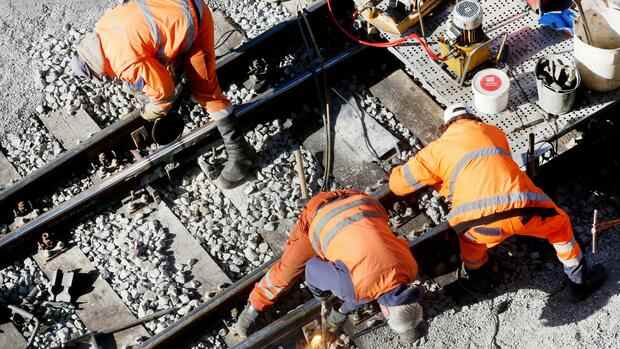Deutsche Bahn has to invest: with 13.6 billion euros it is more than ever. 1,800 kilometers of track, 2,000 points, 800 stations and 140 bridges are on the list.
(Photo: dpa)
Berlin The federal government, representatives of Deutsche Bahn AG as well as industry and freight railways have met for a crisis talk. The reason for this are the ongoing problems on the German rail network, which, according to industry statements, collapsed at the end of last year.
In November and December there were so many construction sites on the German rail network that around a third of freight traffic was canceled according to the railway company – without the network operator explaining the problems. The situation was so bad that even the other railway subsidiary, DB Cargo, had to put off its customers: “We are working hard to improve the ability to plan your trains,” said a customer information.
Industry representatives had reported production outages in the steel and paper industries, and car manufacturers had switched to trucks to ensure production. In view of this, the Federal Ministry of Transport had asked for a meeting at the end of January, in which DB Netz boss Frank Sennhenn also took part.
Federal Transport Minister Volker Wissing describes it as “a huge problem that there is too little rail infrastructure, which causes delays, but that there are even more delays when the infrastructure is expanded. We have to tackle such things in concrete terms.” He is planning short-term measures and wants to restructure the railway and establish a “DB infrastructure” oriented towards the common good. The private railway companies want to be “involved” and demand that the network operator must become a “capacity manager”.
Top jobs of the day
Find the best jobs now and
be notified by email.
After all, the federal government must achieve ambitious climate goals: logisticians and companies should transport around 50 percent more goods by rail by 2030. The climate image does increase demand. At the same time, however, the management and political mistakes of the last 20 years are breaking into the system: for the many construction sites, there are no alternative routes, overtaking tracks, buffer stations; Locomotives are outdated and fail countless times, even the new whisper brakes cause technical problems and thus “damaged wagons” that rob scarce capacities.
“Mitropa waiting room atmosphere like in the best GDR times”
“We are experiencing a huge traffic jam and mega ignorance,” said Sven Flore, head of the cargo division of the Swiss Federal Railways. The companies wanted to be treated as customers. “Instead, there is a Mitropa waiting room atmosphere like in the best days of the GDR,” he complained. For example, DB Netz wants to close the north-south route from Antwerp to Genoa, which is central to freight traffic, for several weeks at Rastatt instead of keeping at least one track open during the work.
Wolfgang Birlin, Managing Director of Rhein Cargo, also speaks of “uncoordinated construction measures”. Construction work has not yet been completed, and new construction sites are already being opened on the alternative route. “Our customers have little understanding for this situation, especially if they can also handle their transports by road. This development runs completely counter to the desired traffic turnaround.”
The railways have worn out the network in recent years, and now they have to invest: at 13.6 billion euros, it is more than ever. 1,800 kilometers of track, 2,000 points, 800 stations and 140 bridges are on the list. The race to catch up led to more than 6,000 construction sites in 2021 alone, 1,000 of them in the DB Cargo network alone, which, according to experts, can handle at most 500 and imposes an “acceptance block” on customers from 750 construction sites.
The federal government has been transferring more than one billion euros to Deutsche Bahn for ten years since 2020 for so-called “customer-friendly construction”, which above all means more employees and machines. Apparently, this has not helped so far: According to the federal government, almost every second freight train in 2021 was at least an hour late at its destination, which disrupts the entire international cargo network.
At the meeting, the entrepreneurs organized in the European Railways network reported that rail freight traffic was “in a desolate state”. At times, the network only performed at 32 percent of its capacity, and 80 percent or more was necessary. The core rail network from the ports to Europe is overloaded, there is a lack of staff at DB Netz, the IT is outdated, construction sites are being organized without considering the customers.
“We weren’t satisfied with our performance either,” said a DB spokeswoman when asked. It drives “a lot of traffic on a scarce infrastructure”. The goal is better construction site management, for which DB Netz boss Sennhenn also made suggestions in the round. It stays with the many construction sites, so there should be another meeting with the customers in March. The round with the officials of the ministry should also be discussed every three months in the future.
More: Possible billion-dollar sale by Deutsche Bahn: Investors are preparing for the Schenker takeover
